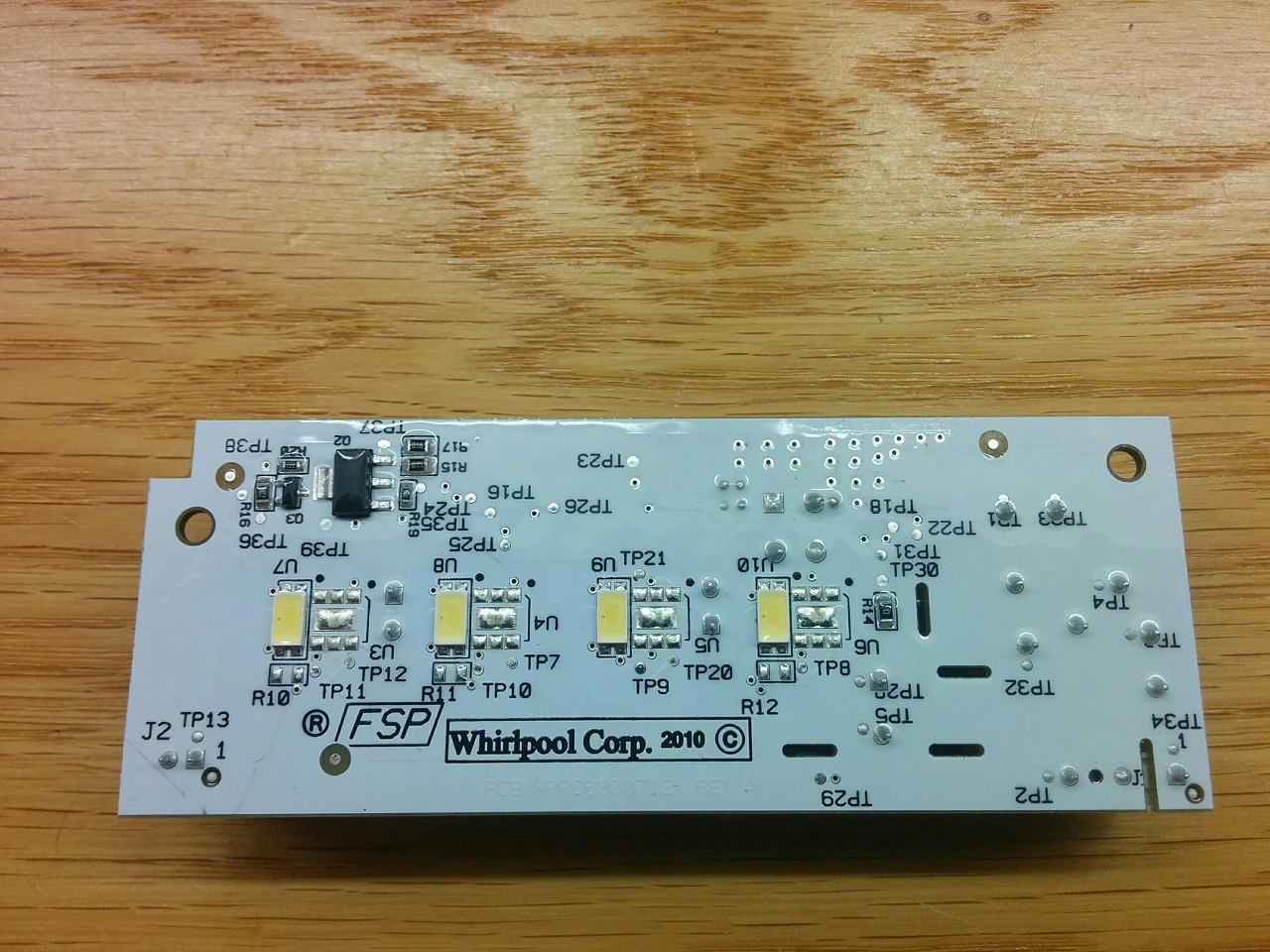I have a Whirlpool side by side fridge that is not even 2.5 years old. Recently the LED lights inside the fridge and freezer started acting up. Instead of fading on when the door was opened, the lights would just flicker slightly. Closing the door and re-opening would seemingly fix the problem. The problem was intermittent, but I figured it was only going to get worse so I decided to do something about it.
After some Internet searches, I determined that I was not the only with with this problem. There were dozens of reports of the problems with the same light module as what is in my fridge (W10515058). There were people that said they light failed when the fridge was just 19 months old. Some folks said they replaced the flickering module (spending between $75-$150) and it failed again in a year or two. There were some helpful videos on removing the module that also had some dubious fix suggestions.
To start with, I removed the module following the instructions in this video: https://www.youtube.com/watch?v=pCY2iaOFgN8
The module has two connectors. The first provides 120v to the board to power the lights when either the fridge or freezer door is opened. The second connector provides DC power to the other lights in the bottom of the fridge and freezer. Once this module is removed, all lights in the fridge will not function.

Upon examining the module, the first thing that strikes me is how well it is made. It is a multi layer board with mainly SMD components. It also has a conformal coating over the board and all components. There is no fancy control logic chip, so I would surmise that the the fade-in effect is orchestrated by a simple resistor-capacitor timing circuit. And this board operates in a nice, constantly chilly environment for 15 to 20 seconds at a time... So what excuse does it have for not lasting 10+ years?
I am going to take a stab at this and say that the problem is with one of the electrolytic capacitors on the board. There are a total of three of these capacitors present, a 3.3uf 400v (C6) and 2x 100uf 50v (C7 + C8). The first one appears to be the primary side filtering capacitor as it is near the 120v connector and in between the 4 diodes that seem to be the rectifier. The issue that I see is that the brand of this capacitor is 'Lelon' which happens to be on our bad capacitor list here. The other two caps are 'Nichicon' which are on our good list.
EDIT: Replacing C6 did not solve the problem! I am still working to find a permanent fix and will update the thread when a solution is found.
EDIT: September 2021:
port443 seems to have found the solution to fix these boards:
slim_jim also fixed his light and noted:
After some Internet searches, I determined that I was not the only with with this problem. There were dozens of reports of the problems with the same light module as what is in my fridge (W10515058). There were people that said they light failed when the fridge was just 19 months old. Some folks said they replaced the flickering module (spending between $75-$150) and it failed again in a year or two. There were some helpful videos on removing the module that also had some dubious fix suggestions.
To start with, I removed the module following the instructions in this video: https://www.youtube.com/watch?v=pCY2iaOFgN8
The module has two connectors. The first provides 120v to the board to power the lights when either the fridge or freezer door is opened. The second connector provides DC power to the other lights in the bottom of the fridge and freezer. Once this module is removed, all lights in the fridge will not function.
Upon examining the module, the first thing that strikes me is how well it is made. It is a multi layer board with mainly SMD components. It also has a conformal coating over the board and all components. There is no fancy control logic chip, so I would surmise that the the fade-in effect is orchestrated by a simple resistor-capacitor timing circuit. And this board operates in a nice, constantly chilly environment for 15 to 20 seconds at a time... So what excuse does it have for not lasting 10+ years?
I am going to take a stab at this and say that the problem is with one of the electrolytic capacitors on the board. There are a total of three of these capacitors present, a 3.3uf 400v (C6) and 2x 100uf 50v (C7 + C8). The first one appears to be the primary side filtering capacitor as it is near the 120v connector and in between the 4 diodes that seem to be the rectifier. The issue that I see is that the brand of this capacitor is 'Lelon' which happens to be on our bad capacitor list here. The other two caps are 'Nichicon' which are on our good list.
EDIT: Replacing C6 did not solve the problem! I am still working to find a permanent fix and will update the thread when a solution is found.
EDIT: September 2021:
port443 seems to have found the solution to fix these boards:
slim_jim also fixed his light and noted:


Comment